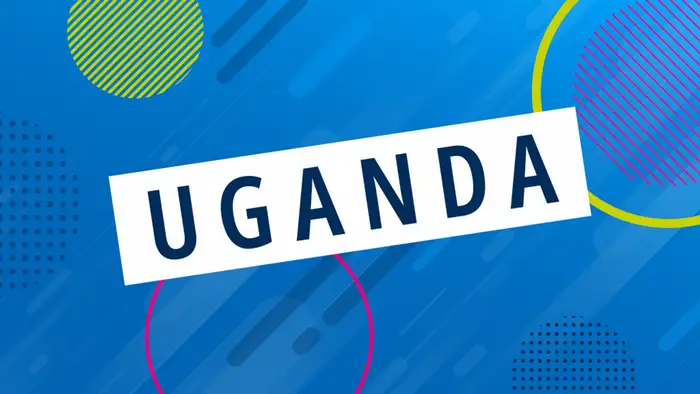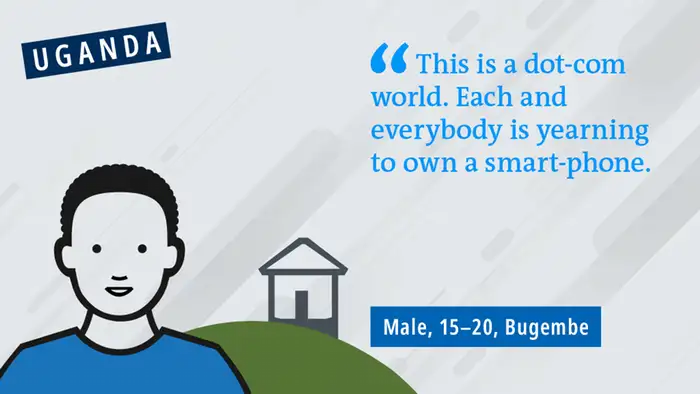MIL Index
Digital, but reserved: Media and Information Literacy amongst Uganda’s youth
Under 35-year-olds in Uganda are facing a hostile digital environment, impeding their participation in public discourse.
Young Ugandans are reluctant to voice their concerns and take part in public discussions according to indicative findings from the MIL INDEX country study presented here. The eight focus groups conducted for the study in Kampala and Bugembe early in 2019 revealed that youths are using both traditional and social media extensively, but discussions of political and public issues take place mainly in closed circles on platforms like WhatsApp. "It is a suffocated environment," says media expert Gerald Businge.
The MIL INDEX study summarized here is aimed at obtaining a concise picture of media- and information-related skills amongst youths under the age of 35 in Uganda. It addresses five dimensions of Media and Information Literacy (MIL) based on DW Akademie’s MIL model: access, analysis, reflection, creation, and action.
In contrast to countries in which representative studies could be conducted (Kenya, Ghana, Burkina Faso), the methodology was purely qualitative, relying on key informant interviews and focus groups. The findings presented are indicative of the state of MIL of young people in urban and peri-urban Uganda but cannot claim to be representative of the entire population. Additionally, there is no score or rating system that allows direct comparisons with the other countries in the overarching MIL INDEX project. Nevertheless, the results do give an indication of where the strengths and weaknesses of the 78 youths involved in the study lie.
Access
The global shift towards digital media, termed "the dot-com era" by the participating youths, has left its mark on media access and use preferences amongst the participants involved in the focus groups. The smartphone is the most popular device and it serves as a benchmark when judging more traditional media (radio, television, and newspapers). Both urban and peri-urban focus group participants still use traditional media and seek out trusted journalistic brands on social media. But there is a feeling that traditional media are losing touch with the Ugandan youth of today. Radio is still valued highly, but mainly as a sign of solidarity for older or physically challenged segments of the population. The groups favor television over radio. There was a general neglect of printed media, based on an unwillingness to read long texts and on a lack of comprehension owing to the high register of printed news publications.
Social media and online messengers, especially Facebook and WhatsApp, play an important role in the lives of youth, some of whom feel they are almost addicted to them. There is a rural-urban divide in media access, especially when it comes to online-based services, as mentioned by both the experts interviewed and the youth focus groups.
Analysis
The Ugandan youths in the focus groups are not very critical of the media environment they live in, although experts and media freedom indices alert to the fact that there are serious issues with censorship, intimidation, media concentration, and associated effects. They do pick up on news bias and sensationalism, but few issues beyond that.
Youths are certainly conscious of the fact that information from online sources and social media should be treated with care. They are also able to differentiate between serious outlets that produce quality content and tabloid-type outlets that have an ambivalent relationship to the truth. It is worth noting that while respondents were very good at answering multiple choice questions on digital and journalistic media, an alarming number of respondents did not know that there is a constitutional right to freedom of expression and that it applies to all citizens.
Reflection
Focus group participants were able to render numerous cases of cyberbullying/hate speech, disinformation, and cybercrime, documenting that these issues are omnipresent and should be of prime concern to MIL practitioners in Uganda. Especially the examples of cyber-harassment revealed that female youths are primarily targeted. At the same time there seems to be little in the way of counselling for victims. The groups rarely reflected the motivations behind such malevolent forms of communication, such as, in the case of disinformation, the polarization of the political landscape in Uganda.
On a positive note, verification strategies were mentioned in several groups as a strategy to overcome disinformation. Cybercrime seems to be a serious issue in Uganda, but it seems youths are left to their own devices and often learn their lesson by falling prey to fraudulent schemes.
Creation
The Ugandan youths in the focus groups displayed basic skills (taking photos, video and audio recording) when it comes to creating media. They rarely go beyond what their smartphone offers them, but they are creative in the way they use the basic skills they do have. Their skills are employed mainly for impression management, less for the common good.
Action
Ugandan youths rarely use traditional and social media to effect change in their society. This has less to do with their abilities than with the inhibiting communication environment that presents itself in Uganda. State control and legislation have led to a withdrawal of many youths into the private realm and closed communication circles. Some youths do play a more active role or aspire to do so. Media formats addressing youth issues seem to be one way in which youths can actually have their say in the public realm. There is an awareness of the fact that the media can help compensate the deficits of the education and health systems, though especially social media can contain unverified content. Youth also use traditional and social media as sources of inspiration for their future aspirations and specifically social media for learning job skills and finding employment. Some participants feel that the traditional media could cater more for their everyday needs.
Conclusion
Ugandan youth are accessing and using digital and traditional media extensively, but very reluctant to make their voices heard in public discussions. There is a tendency to withdraw into the private or closed messenger groups for fear of repression. There is also a worrisome trend toward harassment and fraud in online communication. Youth are especially vulnerable in this regard. The analytical skills of the focus group participants were good, but the results highlight the fact that not only MIL needs to be conveyed, but the toxic digital environment in Uganda also has to be addressed.
Methodological background
For each of the five dimensions (access, analysis, reflection, creation, action), survey respondents received a score ranging between 0 (= no skills whatsoever) and 20 (= highest level of skills) points. The scoring system measures how often certain skills are actually put into practice (access, creation, action) or tests the skills directly (analysis, reflection). Since citizens cannot permanently use media and information sources unless they are journalists or media workers, a perfect score of 100 for any country appears unrealistic—it is more about the relative performance across time, and in comparison to other countries, as well as being a tool for identifying deficits to be addressed in media development.
DW recommends
Downloads
- Date 22.10.2020
- Feedback: Send us your feedback.
- Print Print this page
- Permalink https://p.dw.com/p/3jvHD
- Date 22.10.2020
- Send us your feedback.
- Print Print this page
- Permalink https://p.dw.com/p/3jvHD


